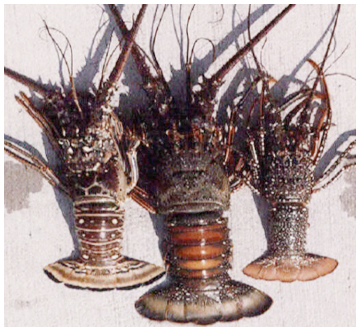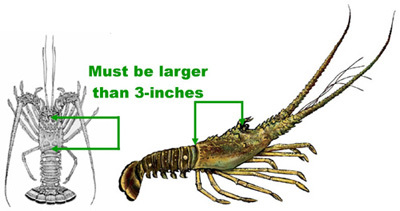
The 2017 spiny lobster season opens with the two-day recreational sport season July 26 and 27, followed by the regular commercial and recreational lobster season, which starts Aug. 6 and runs through March 31, 2018.
Planning on catching some of these tasty crustaceans? Here is what you need to know before you go.
Where to harvest
Know where you can go. Lobster harvest is always prohibited in Everglades National Park, Dry Tortugas National Park, Biscayne Bay-Card Sound Spiny Lobster Sanctuary, certain areas of John Pennekamp Coral Reef State Park, and no-take areas in the Florida Keys National Marine Sanctuary. During the two-day season, all harvest of lobster is prohibited throughout John Pennekamp Coral Reef State Park. Visit MyFWC.com/Fishing and click on “Saltwater,” “Recreational Regulations,” “Lobster” and “Regulations for Recreational Harvest and Lobster Information for Monroe County” to learn more about areas in Monroe County that are open to spiny lobster harvest.
Bag limits
Stick to the bag and possession limits so there will be enough lobsters for all your friends and family. During the two-day spiny lobster sport season, recreational harvesters can take up to six lobsters per person daily in Monroe County and Biscayne National Park waters or 12 lobsters per person daily in other Florida waters. You may possess no more than the daily bag limit of lobsters when you are on the water. When you are off the water, you may possess no more than the daily bag limit on the first day of the sport season and no more than double the daily bag limit on the second day. See the chart below for an easy-to-read guide on the two-day sport season bag limits. During the Aug. 6 to March 31 regular season, the daily recreational bag and on-the-water possession limit is six spiny lobsters per person for all Florida waters.
| Two-day Sport Season | |||
|
Where? |
Daily bag limit and max number you can possess while on the water either day | Max number you can possess off the water on July 27 | Max number you can possess off the water on July 28 |
| Monroe County and Biscayne National Park | 6 | 6 | 12 |
| Elsewhere | 12 | 12 | 24 |
Size limit
 No one wants a small lobster for dinner, and recently approved legislation specifies that each undersize spiny lobster found in a violator’s possession may be charged as a separate offense. In addition, recreational or commercial violators with 100 or more undersized spiny lobsters are to be charged with a third-degree felony. Remember to always check the size of lobster you catch. If the carapace length is not larger than 3 inches, it may not be harvested (see image on how to measure spiny lobster). For divers, measuring devices are required and lobsters must be measured while they are in the water.
No one wants a small lobster for dinner, and recently approved legislation specifies that each undersize spiny lobster found in a violator’s possession may be charged as a separate offense. In addition, recreational or commercial violators with 100 or more undersized spiny lobsters are to be charged with a third-degree felony. Remember to always check the size of lobster you catch. If the carapace length is not larger than 3 inches, it may not be harvested (see image on how to measure spiny lobster). For divers, measuring devices are required and lobsters must be measured while they are in the water.
Egg-bearers
To protect the next generation and your future chances to have lobster for dinner, harvest of egg-bearing females is prohibited. Egg-bearing lobsters have hundreds of thousands of eggs that are easily visible and attached under the tail. While most lobsters have completed reproduction by the start of the fishing season, finding lobsters with eggs is common in July and August.
Nighttime harvest and bully netting
While the waters may be less crowded at night, diving for spiny lobsters after the sun goes down is not allowed in Monroe County during the two-day sport season.
Bully netting, however, is allowed at night, and is a popular method of harvest. Keep in mind, bright lights and loud noise on the water late at night can be disruptive. Keep lights directed down and avoid shining lights at houses along the shoreline. Keep sound levels low when near shoreline residences. Bully netters have a right to fish, but should be courteous of others by minimizing disruptions and not trespassing on private property.
Whole condition
Bring a cooler big enough to hold the entire lobster. Spiny lobsters must remain in whole condition until they are brought to shore. Also, do not take spiny lobster with any device that might puncture, penetrate or crush its shell.
Licenses and permits
Make sure to have the proper paperwork. A recreational saltwater fishing license and a spiny lobster permit are required to recreationally harvest spiny lobsters unless you are exempt from recreational license requirements. Information about these licenses and permits is available online at MyFWC.com/License or you may purchase your license today at GoOutdoorsFlorida.com.
Invasive lionfish
Do double duty while you are in the water and remove invasive lionfish. These nonnative species are often found in the same areas as spiny lobster, and they negatively impact Florida’s native wildlife and habitat. Help keep the lionfish population under control by removing them from Florida waters. If you plan to take lionfish with a spear, be aware of no-spearing zones before planning your spearfishing trips. Learn more about spearing rules by visiting MyFWC.com/Fishing and clicking on “Saltwater Fishing,” “Recreational Regulations” and “Spearing” or “Monroe County Spearfishing.” Visit MyFWC.com/Lionfish to learn more or to participate in the Lionfish Challenge reward program.
Diving safely
Always remember: Safety first. Divers, even those who wade in, should stay within 300 feet of a properly displayed divers-down warning device (red with a white diagonal stripe on a flag or buoy, for example) when in open water and within 100 feet of a properly displayed divers-down warning device if on a river, inlet or navigation channel. Boat operators must slow to idle speed if they need to travel within 300 feet of a divers-down warning device in open water or 100 feet of one on a river, inlet or navigational channel.
Divers-down warning symbols displayed on vessels must be at least 20 inches by 24 inches. If you are using a flag, a stiffener is required to keep it unfurled, it must be displayed from the highest point of the vessel, must be visible from all directions and must be displayed only when divers are in the water. So when the divers are out of the water, don’t forget to take it down. Divers-down symbols towed by divers must be at least 12 inches by 12 inches. More information on divers-down warning devices is available online at MyFWC.com/Boating by clicking on “Boating Regulations.”
More
Additional information on recreational spiny lobster fishing, including how to measure spiny lobster, is available online at MyFWC.com/Fishing by clicking on “Saltwater Fishing,” “Recreational Regulations” and “Lobster.”
